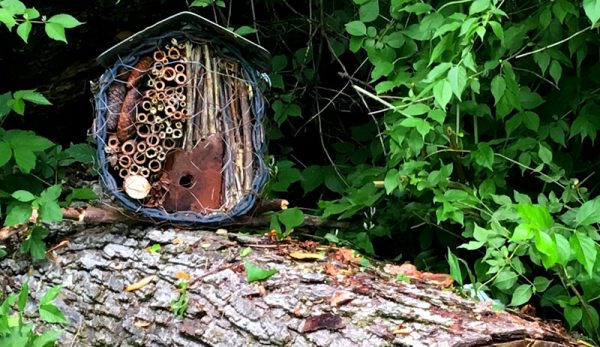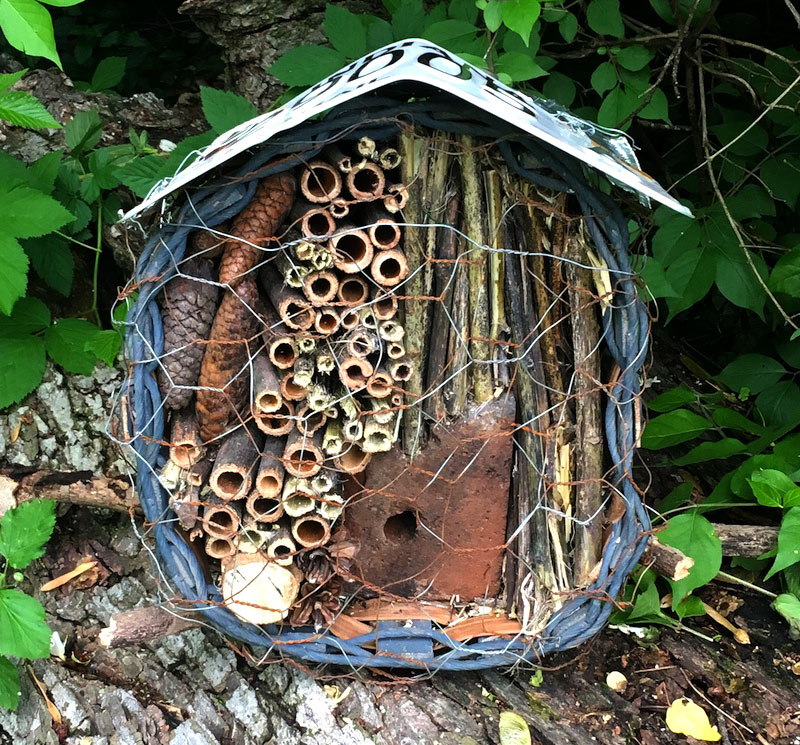
Nearly 4,000 bee species are native to North America—and honeybees are not among them. Nevertheless, as bees go, they get much of our attention. Native bees are highly specialized pollinators in their own right, but they keep a much lower profile. Rather than form large, social colonies as honeybees do, solitary nest-builders mostly live alone.
Still, just as honeybees have lost out on habitat and adequate, pesticide-free forage, so, too, have their solitary sisters. Truly, they all could use our help. Providing these solitary pollinators with food and shelter is surprisingly easy and rewarding.
Tubes and Tunnels
Many solitary bees, including mason bees and leafcutter bees, nest inside small holes they find in trees or inside plant stems. Other smaller bees nest within dried plant debris.
Because mason bees are especially good at pollinating fruit crops, dedicated mason bee houses have become a staple in many orchards. Interested in a small structure that houses only mason bees? Try this design.
Want to give many types of native bees some habitat all at once? Build a mixed-use, solitary pollinator apartment like the one pictured above. You’ll need hollow stems in various diameters, blocks of untreated wood, and thick bundles of dead stems. (All materials must be completely dry.)
You also need a container at least eight inches deep. (A birdhouse with the front removed can work well. So can baskets without handles or deep drawers turned on their sides.) Finally, you need something to serve as a water-resistant roof. This could be a piece of untreated wood topped with roofing shingles, scrap metal or even a flat, plastic lid.
To get started, cut 8-inch lengths of hollow stems. Make sure they are smooth and empty inside. Bundle these and pack them into your container.
Add an 8-inch section of untreated wood. (To attract mason bees, use a 5/16 bit to pre-drill several holes, each at least 6 inches deep. To attract carpenter bees, leave the wood without holes.)
Now place multiple bundles of the dead stems vertically inside your container. These accommodate especially small native bees. Continue to fill the container with hollow stems, wood blocks and vertical stem bundles until it is tightly stuffed with various habitat types. (For added variety, include pine cones, pieces of soft brick, dried leaves or similar materials.)
Position roofing atop your container such that all nest materials will remain dry. To keep hungry, opportunistic birds away, cover the front of your container with chicken wire.
Install your solitary pollinator apartment in a south-facing location a few feet off the ground. For more detail on construction and long-term upkeep, download Marc Carlton’s “How to Manage a Bee Hotel.”

Bare Spots and “Bee Banks”
Although miner bees won’t move into your solitary pollinator apartment, you easily can provide habitat for this bee as well. There are about 1,200 different species of this type of native bee in North America. Miner bees burrow into the soil to raise their young, and, to help them, you need only uncover some out-of-the-way areas in your yard or garden.
Ideally, you should provide a sunny, relatively dry location. When you’ve chosen a good spot, simply remove the top layer or grass, weeds and any other plant matter to expose a patch of bare dirt. Miner bees dig down into these bare patches to create miniature burrows. Inside their burrows, they lay eggs and pack with a mixture of nectar and pollen.
If you’re up for a more involved project, you might install a bee bank. This is a relatively large, shelf-like area amended with coarse sand. You can find instructions for building and managing a bee bank here.
In the Garden
In addition to shelter, you should provide native solitary bees with many different nectar and pollen sources. Solitary pollinators come in various shapes and sizes—and the length of their tongues also differs. So, while some can access long-necked flowers, others require much smaller, more compact floral arrays.
By planting as many different native flowers as you can, you’ll accommodate the needs of more bee species. Allowing some patches of non-invasive weeds to flourish can help, too.
Perhaps most important? Make your space a 100 percent pesticide-free zone. After all, even “natural,” plant-derived pesticides harm the creatures you’re working to attract. Rather than break out the spray? Be prepared to hand-pick those squash beetles and tomato hornworms.
Further Reading
Want to dig deeper on native pollinators? Check out Attracting Native Pollinators or download this free pollinator conservation resource, “Four Principles to Help Bees and Butterflies.”




